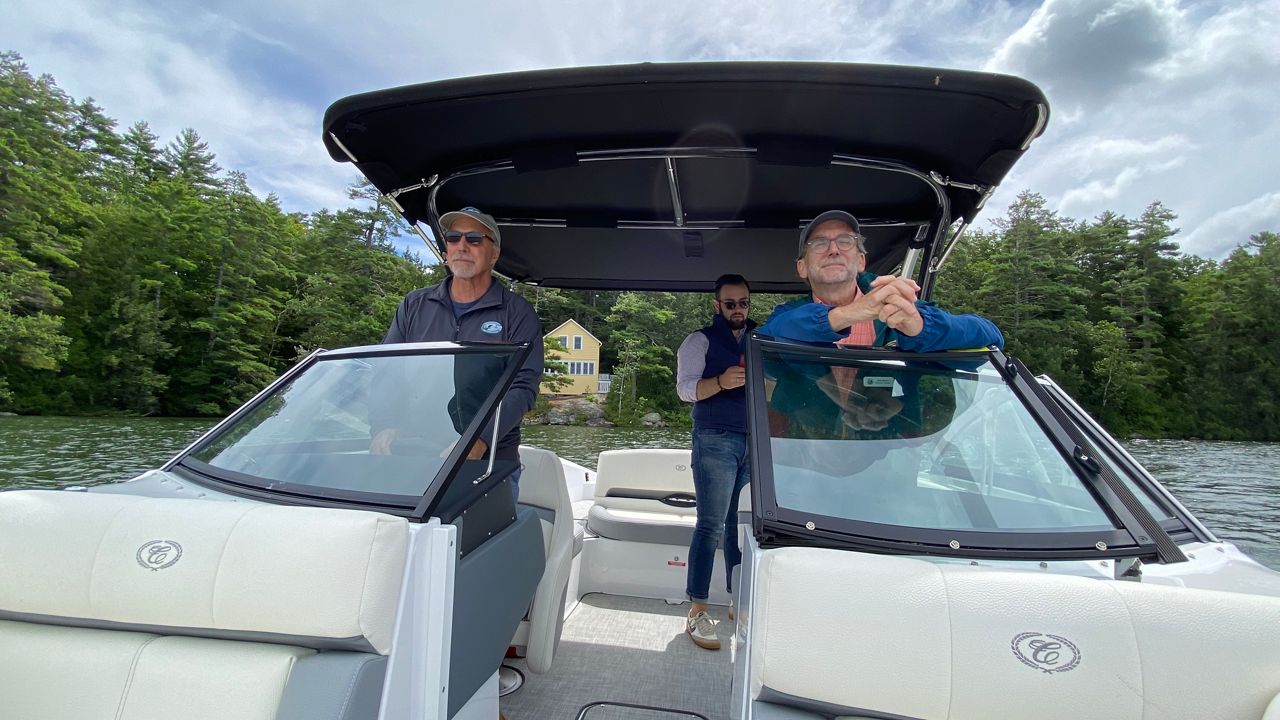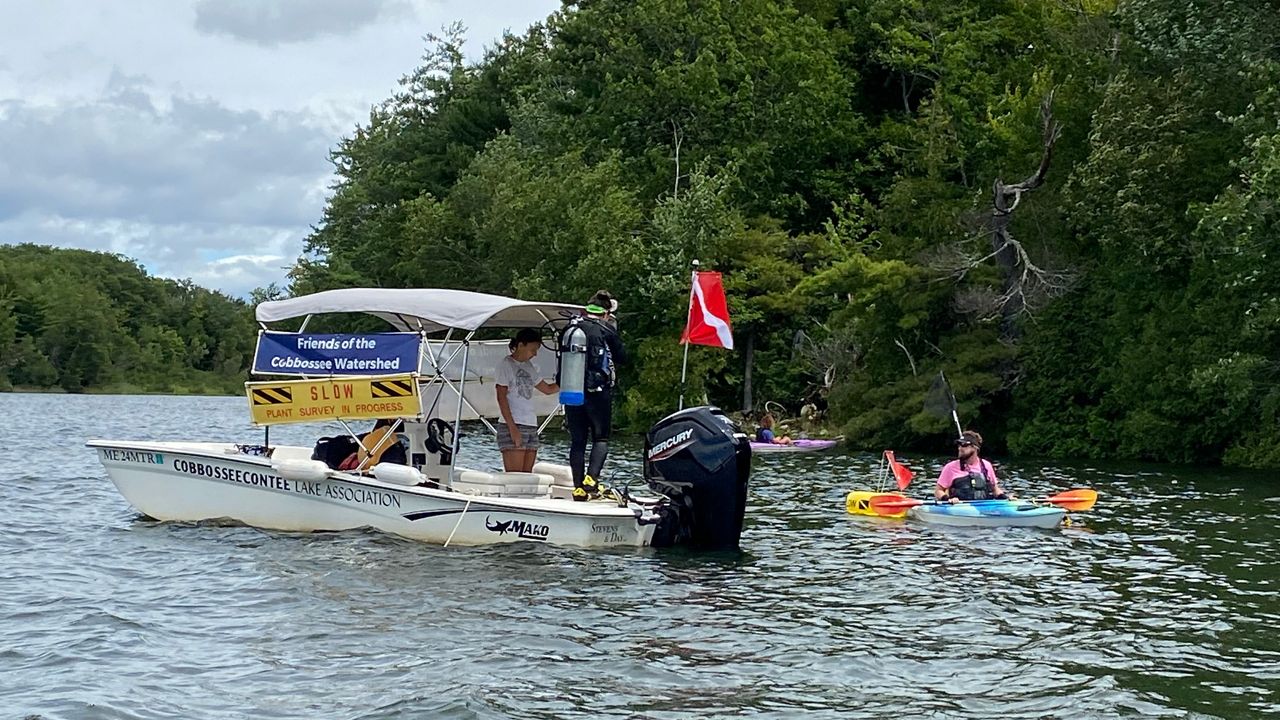Diver Alex Dyer jumped off the side of a boat into Cobbosseecontee Lake Wednesday and quickly re-emerged with a clump of Eurasian water milfoil in her hand.
Using GPS mapping, she and others guided their boat to various locations to remove the “extremely aggressive plant” before it can take hold in other parts of the lake.
And though invasive plants have been found in 32 bodies of water in Maine, Cobbosseecontee is the only public body of water in the state with Eurasian water milfoil, said John Weaver, president of the lake association.

(John Weaver, president of the Cobbosseecontee Lake Association, left, and Tom Mullin, executive director of the Friends of the Cobbossee Watershed, watch a crew remove invasive Eurasian water milfoil from the lake on Wednesday. (Spectrum News/Susan Cover)
“This is the one we’ve all been worried about,” he said.
That’s because in other states, the invasive plant has virtually taken over entire lakes, creating thick mats of vegetation that even boats cannot pass through.
“It impacts the fish population, invertebrates, insects and in some cases across the country, boaters cannot go where they used to go,” said Tom Mullin, executive director of the Friends of the Cobbossee Watershed.
The lake association and friends group work together to raise public awareness about invasive plants, training people how to spot them and providing inspectors at boat launches to make sure boats coming in and out of the lake are clean.
They also work with the Maine Department of Environmental Protection on mitigation efforts.
On Friday, the DEP will send a company to treat areas of the lake with herbicide to kill the milfoil. Although there are no restrictions on recreational uses at the lake, the DEP advises against swimming or boating in the treatment areas that day.
John McPhedran of the DEP’s Invasive Aquatic Species Program said they’ve treated various areas in the lake since 2018.
They are particularly worried about a new discovery of the Eurasian water milfoil near Cobbossee Stream, which runs to Horseshoe Pond and eventually to the Kennebec River.
“Eradication is the goal, but it’s becoming clear it may be more difficult to achieve,” he said.
Separately, the dive team worked Wednesday near Horseshoe Island, where the Eurasian water milfoil has been spotted. The cove in the middle of the horseshoe is a popular place for boaters to drop anchor and swim.
On a recent weekend day, Weaver said he saw 20-30 boaters enjoying the cove, which is part of the lake that covers 5,516 acres with waterfront homes and camps in Litchfield, Manchester, Monmouth, West Gardiner and Winthrop.
And even though many of the 917 landowners along the lake are members of one or both groups, their efforts to preserve the water quality go beyond protecting property values, Mullin said.
“There are thousands of people who use the lake who live elsewhere,” he said.
It’s also home wide array of wildlife. During a short boat ride out to the dive site Wednesday, eight loons floated by and an osprey and eagle flew overhead.
Earlier this year, Brian Kavanah, director of the Bureau of Water Quality for the Maine DEP, described to lawmakers the impacts of invasive plants such as the Eurasian water milfoil.
“Infestations result in habitat disruption, loss of property values, diminished water quality, reduced fishing and water recreation opportunities, and significant expense for mitigating these environmental and social impacts,” he said in support of a bill to strengthen state laws that govern invasive aquatic plants.
A different law that went into effect in June requires boaters to drain their boats before they enter the water and every time they leave to prevent the spread of invasive plant and animal species, according to a joint press release issued Wednesday by DEP and the Maine Department of Inland Fisheries and Wildlife.
That includes hull drains, bailers, live wells and ballast tanks, which should be emptied far enough away from the water so it doesn’t flow back to the lake.
Similar laws are already in effect in 20 other states, including New Hampshire, Vermont and New York.
“This law will limit the spread of aquatic invasive species we already have in Maine while proactively limiting potential for the introduction of aquatic invasive species that would be new to the state such as quagga mussels and the spiny water flea,” according to the release.
Eurasian water milfoil was first discovered in a Maine lake in 2008 when it was found in Salmon Lake in Belgrade and Oakland. Prior to that, it had only been found in a gravel pit in Scarborough, according to the state.
At that time, 29 out of Maine’s 5,700 ponds and lakes had an invasive aquatic plant species.
As of January 2023, that number had risen to 35, according to the Maine Department of Environmental Protection.
McPhedran said groups like those led by Mullin and Weaver are integral in the fight to prevent the spread of the invasive species.
But so too are kayakers, paddleboarders and boaters who use the lakes.
“What this highlights is the need to prevent the spread,” he said. “It’s the best bang for the buck and it can be done. That is so critical.”



